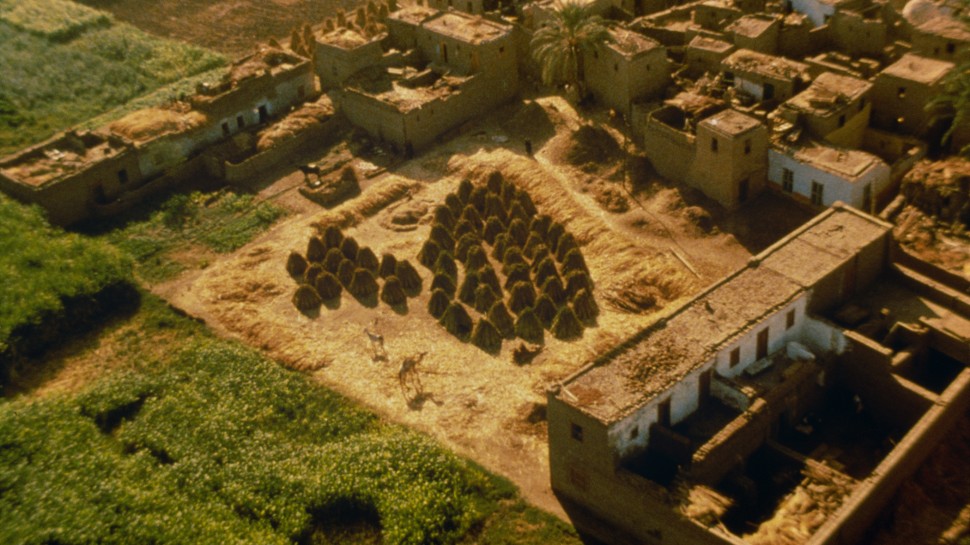
Powaqqatsi
Screening on Film
$12 Special Event Tickets
US, 1988, 35mm, color, 99 min.
Print source: HFA
Each Qatsi film is introduced by a particular metaphor. The subject of Koyaanisqatsi is the ever-more-frenzied way of life that threatens to rocket us into oblivion; the subject of Powaqqatsi is the third-world labor that makes modern society possible. That film’s spectacular opening shots focus on hundreds of men working up and down the steep walls of the Serra Pelada gold mine in northern Brazil. While viewers will be appalled at this exhausting labor, the strength and stamina of the men are impressive, even exhilarating; they are beautiful to watch, often reminiscent of classic statuary. The sequence suggests that the men and women in the Southern Hemisphere who do so much of the world’s dirty work are like Sisyphus in their unrelenting toil and like Christ in the sacrifice of their lives for others (at its end, several workers carry an injured or exhausted man up the mine wall in a manner that evokes the Crucifixion and the Pietà). Of course, the kind of labor we are watching has been part of human societies for millennia—it is what raised the pyramids and the Great Wall of China.
Powaqqatsi’s kinetic opening sequence and title card are soon followed by a fifty-two-second shot of two women carrying huge bundles on their heads in the early-morning mist. The Glass accompaniment emphasizes the quiet grace of their movements, which have the impact of a miraculous dance. Powaqqatsi goes on to take us from one location to another, presenting consistently remarkable slow-motion imagery in extended shots that allow for contemplation of the variety and beauty of individual laboring human beings. Leonidas Zourdoumis and Graham Berry were the cinematographers, and Philip Glass’s score provides a somber, respectful lyricism.
Many of Powaqqatsi’s most memorable shots involve children. Early on, an eighty-seven-second tracking shot pans across the faces of dozens of African boys and girls: their varied reactions to the camera are lovely and compelling, and the myriad physical and psychological differences among them offer a critique of conventional cinema’s frequent use of third-world characters as types. One of the most electrifying shots in the film—really a single extended shot divided in two—is of a small child walking along a highway toward the camera, a huge truck approaching him from behind. At first it appears as if the truck might hit the boy; when it does finally pass him, he disappears in a cloud of dust. The shot seems to end. Then, after much other imagery has intervened and most viewers have probably understood the child’s disappearance as a metaphor for the destruction of childhood by the circumstances of industrialization, Reggio returns to the shot: the thick dust is dispersing and the boy is still walking, unscathed and seemingly unaware that anything unusual has occurred. The moment is transformed into a metaphor for the strength and resilience of third-world children and for their ability to confound our assumptions. The forms of labor Reggio depicts in Powaqqatsi may be ancient, but the laboring world is also full of youthful energy.
The imagery in Powaqqatsi is arranged into an overall montage punctuated by sequences that explore particular themes, within a trajectory that moves generally from rural to urban scenes. While the pervasive use of montage in American television advertising functions as a polemic for ever-greater levels of consumption (of products, of film images per minute), Reggio’s montage is as serenely paced as his individual images. It demands that we meditate on individual human beings in those sectors of the world where life is governed by the patterns of consumption we and others like us have set in motion—the patterns revealed by the time-lapse imagery in Koyaanisqatsi. One might object that Reggio himself is using a high-tech industrial process to mount his challenge to industrial society, but as he has said, “No Immaculate Conception is taking place . . . I see myself as a cultural kamikaze, as a Trojan horse, using the coinage of the time in order to raise a question about that very coinage.”
Powaqqatsi was shot in multiple locations, primarily Brazil, Egypt, Hong Kong, India, Kenya, Nepal and Peru. Indeed, along with Peter Watkins’ The Journey (1987) and Ron Fricke’s Baraka (1992), Powaqqatsi was part of a move during the waning days of the cold war to use modern filmmaking techniques to take account of the diversity and interconnection of the world’s peoples.
Like Koyaanisqatsi, Powaqqatsi is defined only at the conclusion of the film—as “an entity, a way of life, that consumes the life forces of other beings in order to further its own life”—confirming Reggio’s implicit call for a global transformation in the interests of humanity and the environment. But Powaqqatsi can also be understood as a comment on the cinematic experience itself—after all, Reggio is a sorcerer: if his interest in exoticizing the familiar and familiarizing the exotic recalls the Lumières, the brilliant use of slow-motion, time-lapse, aerial and telephoto photography in his films ties him just as fully to Georges Méliès and the invention of film magic. – Scott MacDonald
PRECEDED BY
-
Anima Mundi
Directed by Godfrey Reggio.
Italy, 1991, 35mm, color, 28 min.
Print source: HFA







